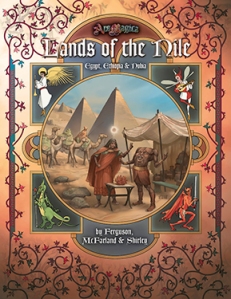Design Note: this is the second post in a series about the East African area of the Erythrean Sea and draws on material from the supplement Lands of the Nile (pages 10-11) and the Appendix A “Languages and Name” section of the Cradle and the Crescent.
The following languages are spoken on or around the Red Sea and the Erythrean Sea. Most characters should take the appropriate dialect as a specialty but educated or well-travelled speakers will have tried hard to rid themselves of their dialect and may have standard specialties (see ArM5, page 66).
Amharic
Arabic (Masri, Khaliji, Maslawi, Shirvani, Somalian)
Bantu (Kiswahili, many other mainland dialects)
Faerie Speech*
Malagasy
Nubian
Somali (Northern, Mogadishan)
Soqotri
Languages of the Red Sea
The most common Arabic dialects spoken in the northern areas and by most traveling merchants and sailors is either the Egyptian Masri or Arabian Khaliji dialect (the latter usually spoken with unique Yemeni and Omani idioms and inflections). Merchants and seafarers from further afield will use either the Levantine dialect or if originally hailing from Basra or nearby ports, the Persian Maslawi dialect. Due to the short distance across the Arabian gulf, the variant Somalian Arabic is spoken by many southern Arabian natives and differs enough from the form spoken elsewhere in Arabia to be classed as a separate dialect.

Somali is the common language of the Bilad al-Berbera, the southern coast of the Arabian Gulf comprising the Horn of Africa. It is very distantly related to both Coptic and Arabic and currently uses the so-called Wadaad version of the Arabic script, although older inscriptions using can be found using a unique native alphabet. Soqotri was once a closely related tongue but has become distinct enough recently to be unintelligible to outsiders. It is rarely heard outside of the isolated island as its merchants and spies use Arabic or rarely Somali when moving through the wider world.
Languages of the Erythrean Sea
Bantu is the anachronistic umbrella term used here to describe a variety of related languages spoken by mundane inhabitants of the hinterland region of the Bilad al-Zanj often enslaved by the coastal towns. The most commonly heard dialect is Kiswahili (or Swahili), spoken in the Arabicized island trade settlements of the coast and island states. It contains many Arabic and Persian loan words and fast becoming the Erythraean Sea’s equivalent of the Mediterranean’s lingua franca. Unlike the other Bantu dialects, Kiswahili is written using the Arabic script.
Shirvani Arabic is an unusual dialect only spoken on the islands of the southern seas, particularly by inhabitants of Qumr. It includes some Bantu derived phrases but mainly borrows Persian words as it was brought to the area by exiles from Shirvan in northern Persia.
Malagasy is an unusual magical language spoken only by the cannibals of Waq al-Waq to the far south and sometimes the rarely encountered Faerie blooded merchants claiming to be from far off ports of the Bahr al-Harkand on the route to Serica. The exact relationship between the two groups is unclear but their language is completely unrelated to the other languages of the region. The exotic merchants sometimes use an unusual Arabic based script they refer to as Sorabe.
What Language do the Faeries Use?
The area of the Erythrean Sea is beset by Faeries claiming to be exotic but mundane merchants or sailors from distant lands such as al-Hind, the hinterland of al-Zanj and the far distant ports of Serica. Instead of speaking mundane dialects, these creatures use a magical ability to interact and carry out their roles in stories. Close observers will note that although these Faeries may appear to speak their own language, the words have no meaningful structure or grammar, merely serving to enhance the creature’s exoticism.
Faerie Speech is not actually a separate language but a Faerie Pretense (see Realms of Power: Faerie, page 50). Characters that possess this Minor Virtue are able to converse with humans as if they know the language being spoken, allowing them to appear to always know how to talk to anyone they encounter.
Dead Languages
Ge’ez
Sabaean
Ge’ez is the Semitic forebear of Amharic using it’s own unique alphabet. It is the ancient language of Axum and still used in the Ethiopian Orthodox Church’s liturgy. Sabaean is the magical language of the ancient Kingdom of Sheba and can still be seen inscribed in either the Masnad or Zabur scripts on ruins and scrolls respectively found in contemporary Yemen.
Languages Penalty
Same language, different dialect -1
Arabic (Somalian) vs Somali -2
Somali vs Soqotri -3
The other pairs of languages are so distinct from each other that comprehension is likely to be based on signing and good guesswork, or magic such as the use of the Gift of Tongues Virtue or the Faerie Speech Pretense (see above).





